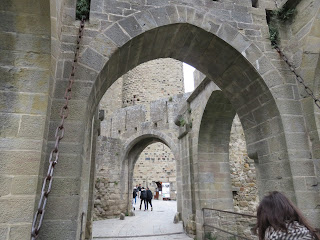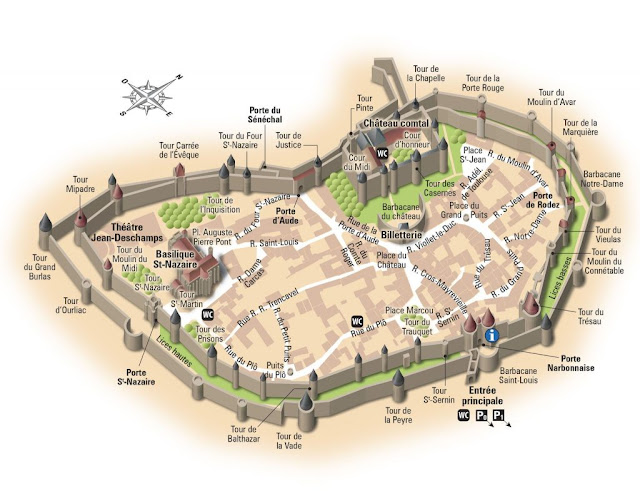Kim is finally feeling up to traveling, so today we are headed to Carcassonne in 2 cars.
This time we are coordinated and both arrive at the parking lot outside this walled city at the same time, just outside the city gate near the cemetery. The day is gray and chilly, but at least it's not raining. Armed in layers, we set off.
 |
| the cemetery outside the walls of Carcassonne |
Carcassonne is one of the must-see sights of Southern France - a perfectly intact medieval city - or at least as imagined by Eugène Viollet-le-Duc in the 19th century.
This important 13th century fortified city had fallen to ruins, then restored as it became a historic monument in the mid-1800s. (For more info on the restoration process: https://www.remparts-carcassonne.fr/en/discover/viollet-le-duc-s-restoration)
This is no Disneyland fanciful pretend city, but a city that helps us understand life in the wild-west of the medieval times without giving up our 21st century comforts - like shopping and cassoulet for lunch in a local restaurant. And of course, the opportunity to buy souvenirs.
 |
| There are lots of tourist shops selling child size gear for young knights. |
Local legend says the city was named after a Madame Carcas. In the 8th century, so the story goes, Charlemagne laid siege to the town (at the time under Muslim rule). After 5 years of withstanding the siege, Dame Carcas had the idea to throw a whole pig, stuffed with wheat, off the highest city tower. Charlemagne, on seeing the sacrificed pig, assumed that the town must have enough supplies to outlast his siege and so packed up his troops and departed. To celebrate the victory, Dame Carcas ordered the city bells to be rung. ("sonner", in French). Hence the name, Carcassonne.
 |
| Dame Carcas greets us at the Porte Narbonnaise |
We entered by the main gate (Porte Narbonnaise) and I immediately learned that my teeth would chatter today, not from the cold, but from clattering over the cobblestone streets.
 |
| Porte Narbonnaise |
The tourist office is just inside the city at this gate.
 |
| Look for the "i" which is always outside the tourist office (Office de Tourisme) |
We made our way up to the count's castle (Chateau comtal) where Dave, Janis, Clark, Kim and Dale bought tickets and crossed the dry moat to explore the castle.
 |
| This bridge connects the castle to the rest of the city and controls the entry to the castle by means of the dry moat (meaning the moat doesn't have water in it. |
 |
| Janis, Clark, Dale, Dave, and Kim crossing the moat bridge |
Inside the castle there are great views of the city.
 |
| looking from the castle across the moat to the barbican (a defense of the entrance to the castle) |
Models and explanations showed how the castle was defended.
You can see where the soldiers would shoot arrows through the stone crenelations and wooden "hourds" built along the walls.
 |
| Archers could shoot arrows between the stone crenels of the outer walls |
 |
| view from inside the hourdings |
 |
| view of how hourdings look from the outside around the tower |
I waited in a little park next to the Barbican Gate since the castle is not handicapped accessible - as would be expected - which is OK as I've seen it before and remember it quite well. Except that it's hard to stay warm while I wait.
 |
| park outside the barbican |
Only once was Carcassonne forced to capitulate. In 1209, Simon de Montfort's Papal army captured the city and forced its Cathar population to leave the city, imprisoning only the city's viscount, Raimond-Roger Trencavel. A second rampart was later built around the walled town and Carcassonne was never conquered again. The space between the two walls, called "les lices" is just over 1 km and a lovely walk away from the congestion of the town.
The castle tour finished, we made our way toward the Basilique St Nazaire, passing the other entrance gate, the Porte d'Aude, along the way. We only looked from the outside because it was time for lunch
and we had reservations at La Table d'Alaïs at noon. A bit early, we checked out the menu and tried to stay warm.
Once inside, we had a delightful lunch with impeccable service. Of course, we all ordered cassoulet which was delicious and very reasonably priced.
 |
| Cassoulet all around |
Lunch finished, we headed back to the basilica to see the inside. The Romanesque nave is all that remains of the early cathedral. In the 13th century, the Romanesque apse was destroyed and a larger Gothic church was built around the Romanesque nave.
 |
| nave looking toward the altar |
 |
| Gothic altar |
 |
| nave looking toward the organ |
 |
| stained glass in the apse |
 |
| one of the transept rose windows |
We spent a lot of time inside the church in awe of its size, shape, and beauty. When we'd got our fill of beauty, we wandered once more across the cité and left as we had come in.
 |
| Dale at the well - an important resource for a city under siege |
 |
| back to the Porte Narbonnaise |
It's a 2 hour trip back to Le Cazal and time for aperos.












No comments:
Post a Comment